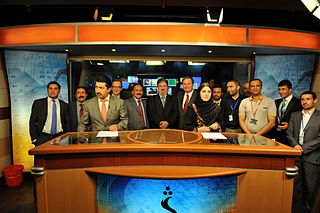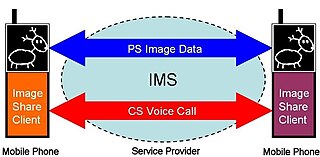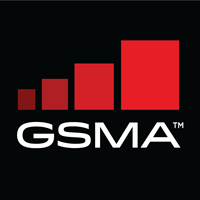
Communications in Afghanistan is under the control of the Ministry of Communications and Information Technology (MCIT). It has rapidly expanded after the Karzai administration took over in late 2001, and has embarked on wireless companies, internet, radio stations and television channels.

The Global System for Mobile Communications (GSM) is a standard developed by the European Telecommunications Standards Institute (ETSI) to describe the protocols for second-generation (2G) digital cellular networks used by mobile devices such as mobile phones and tablets. It was first deployed in Finland in December 1991. By the mid-2010s, it became a global standard for mobile communications achieving over 90% market share, and operating in over 193 countries and territories.

SMS is a text messaging service component of most telephone, Internet, and mobile device systems. It uses standardized communication protocols to enable mobile devices to exchange short text messages. An intermediary service can facilitate a text-to-voice conversion to be sent to landlines.

Roaming is a wireless telecommunication term typically used with mobile devices, such as mobile phones. It refers to the mobile phone being used outside the range of its home network and connects to another available cell network.
Multimedia Messaging Service (MMS) is a standard way to send messages that include multimedia content to and from a mobile phone over a cellular network. Users and providers may refer to such a message as a PXT, a picture message, or a multimedia message. The MMS standard extends the core SMS capability, allowing the exchange of text messages greater than 160 characters in length. Unlike text-only SMS, MMS can deliver a variety of media, including up to forty seconds of video, one image, a slideshow of multiple images, or audio. The first MMS-capable phones were introduced around 2002 in conjunction with the first GSM network. The Sony Ericsson T68i is widely believed to be the first MMS-capable cell phone, while many more hit North American markets beginning in 2004 and 2005.
Network switching subsystem (NSS) is the component of a GSM system that carries out call out and mobility management functions for mobile phones roaming on the network of base stations. It is owned and deployed by mobile phone operators and allows mobile devices to communicate with each other and telephones in the wider public switched telephone network (PSTN). The architecture contains specific features and functions which are needed because the phones are not fixed in one location.
Global System for Mobile Communications (GSM) services are a standard collection of applications and features available to mobile phone subscribers all over the world. The GSM standards are defined by the 3GPP collaboration and implemented in hardware and software by equipment manufacturers and mobile phone operators. The common standard makes it possible to use the same phones with different companies' services, or even roam into different countries. GSM is the world's most dominant mobile phone standard.
Enhanced Messaging Service (EMS) is a cross-industry collaboration between Samsung, Ericsson, Motorola, Siemens and Alcatel, among others. It is an application-level extension to Short Message Service (SMS) for cellular phones available on GSM, TDMA and CDMA networks.
An SMS gateway or MMS gateway allows a computer to send or receive Short Message Service (SMS) or Multimedia Messaging Service (MMS) transmissions to or from a telecommunications network. Most messages are eventually routed into the mobile phone networks. Many SMS gateways support media conversion from email and other formats.
Truphone is a GSMA accredited global mobile network that operates its service internationally. The company is headquartered in London and has offices in ten other countries, being spread across four continents.

Axis is an Indonesian cellular service owned by XL Axiata, a subsidiary of the Axiata Group. It provides 2G, 3G and BlackBerry services nationwide and covers the world through 382 international roaming partners in 159 countries.

Video Share is an IP Multimedia System (IMS) enabled service for mobile networks that allows users engaged in a circuit switch voice call to add a unidirectional video streaming session over the packet network during the voice call. Any of the parties on the voice call can initiate a video streaming session. There can be multiple video streaming sessions during a voice call, and each of these streaming sessions can be initiated by any of the parties on the voice call. The video source can either be the camera on the phone or a pre-recorded video clip.

Image Share is a service for sharing images between users during a mobile phone call. It has been specified for use in a 3GPP-compliant cellular network by the GSM Association in the PRD IR.79 Image Share Interoperability Specification.
Rich Communication Services (RCS) is a communication protocol between mobile telephone carriers and between phone and carrier, aiming at replacing SMS messages with a text-message system that is richer, provides phonebook polling, and can transmit in-call multimedia. It is part of broader IP Multimedia Subsystem.

IP exchange or (IPX) is a telecommunications interconnection model for the exchange of IP based traffic between customers of separate mobile and fixed operators as well as other types of service provider, via IP based Network-to-Network Interface. IPX is developed by the GSM Association.
A GPRS roaming exchange (GRX) acts as a hub for GPRS connections from roaming users, removing the need for a dedicated link between each GPRS service provider. It was developed to facilitate a more efficient way for operators to interconnect networks, and played a large part in the transition to third-generation systems.
Iristel is a Canadian provider of Voice over Internet Protocol services, and is designated as a competitive local exchange carrier. The company was founded in 1999, and is headquartered in Markham, Ontario.

The GSM Association is an industry organisation that represents the interests of mobile network operators worldwide. More than 750 mobile operators are full GSMA members and a further 400 companies in the broader mobile ecosystem are associate members. The GSMA represents its members via industry programmes, working groups and industry advocacy initiatives.

BICS is a telecommunications provider that provides wholesale carrier services to wireline and wireless operators and service providers globally. It is a subsidiary of Proximus Group. The company was founded in 1997 and is headquartered in Brussels, Belgium with sales offices and Service Operation Centers worldwide, including Dubai, Singapore, Bern, San Francisco and New York. BICS provides voice, connectivity, messaging, roaming and mobile connectivity services to over 1,100 fixed and wireless carriers and service providers, including more than 500 mobile operators. In 2012 BICS processed 28 billion international minutes and generated revenues for 1,65 Billion Euros.
TADIG code is a number uniquely identifying network operators in a GSM mobile network. The acronym TADIG expands to "Transferred Account Data Interchange Group". According to the GSM specification, the codes are used as "primary identifiers within file contents and file names" in multiple file formats defined by the GSMA. Network operators are required to register new codes and limit themselves to using code already registered with the GSMA.









